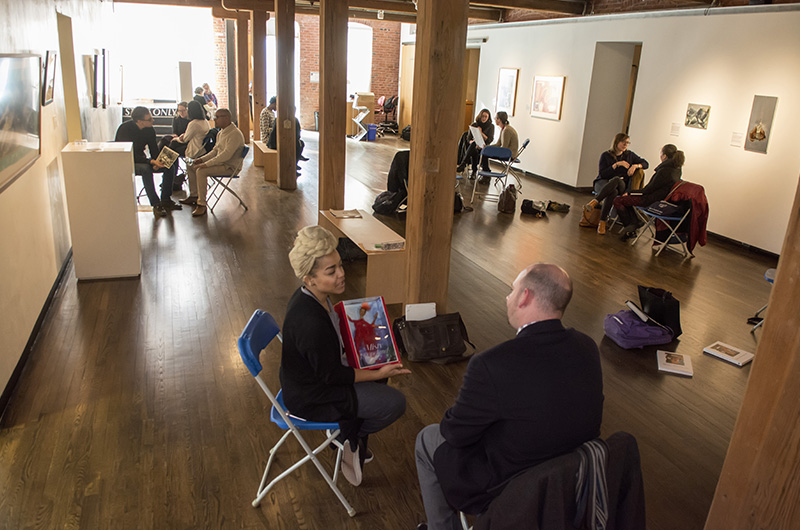Fo-Wilson : A journey with objects
Visiting scholar Fo Wilson delivers annual Jones Lecture, leads workshop

At the 40-acre Lynden Sculpture Garden in Milwaukee, Wisconsin, determined visitors can make their way across a field, some distance from the other exhibits, to a small cabin with a tiny but inviting front porch and one open wall.
The installation, constructed in the manner of a 19th century Southern slave cabin, holds an amazing assortment of objects collected by its fictional inhabitant, Eliza. Copies of the Emancipation Proclamation paper the ceiling, framed family photographs hang on one wall, and turtle shells, bird?s nests and other natural objects are displayed in bell jars on shelves.
The creator of the imaginative ?Eliza?s Peculiar Cabinet of Curiosities,? Chicago artist and professor Fo Wilson, visited the University of Delaware recently to talk about that piece and her other work, to deliver a lecture on racial issues and representations of blackness and to lead a workshop in material culture.
Her description of the ?Eliza? installation was part of the 2017 Paul R. Jones Lecture that Wilson gave on March 15.
She began her talk, titled ?The Liminality of Race and Representations of Blackness,? by defining liminality as the transitional stage of a process or the position at, or on both sides of, a boundary or threshold.
Today, ?I think the whole country is in a liminal state ? not only on the threshold of change? but having actually crossed a boundary and becoming something different, Wilson said.
But, she said, ?Black and brown bodies have been in a perpetual state of liminalness? since they were first brought to America as enslaved people.
As a result, African Americans have developed what Wilson called ?black technologies,? or ways of expressing both their resistance and their humanity. She cited the experience of ?double consciousness,? first described by W.E.B. Du Bois as the conflict between his African American identity and the way in which he was viewed by a racist society, and the call-and-response tradition in African American culture as a form of communal engagement and acknowledgement of others.
Two days before delivering the lecture, Wilson led a multidisciplinary workshop for UD faculty, students and staff focused on art and material culture. Her visit to campus encompassed roles as the 2017 Paul Jones lecturer and also as the second distinguished visiting scholar in the University?s African American Public History and Material Culture series.
The workshop was held in Mechanical Hall Gallery, which houses the Paul R. Jones Collection of African American Art and, through May 12, the exhibition ?So What Have We Learned: Black Visual Cultures @ UD.?
Julie McGee, associate professor of Black American studies and of art history and associate director of the College of Arts and Sciences? Interdisciplinary Humanities Research Center (IHRC), introduced Wilson to the workshop participants, saying, ?She is going to lead us on a journey related to objects.?

Those taking part in the workshop brought an object that represented their field of study or other interests or that has motivated them in their lives, and they explained the meaning to the group.
Undergraduate student Ikira Peace, a dancer since age 5 now in UD?s dance minor program, brought a doll portraying Misty Copeland, the American Ballet Theatre?s first African American principal dancer. Copeland?s story reminds her of her own life, Peace said, and inspires her to continue her dance training.
Other workshop participants brought family heirlooms?a ceramic milk jug from Maryland?s Eastern Shore, an Irish ring from an 1895 wedding, even a 1970 high school yearbook?and told the stories behind them.
Ethan Scott Barnett of Brooklyn, New York, who plans to enter UD?s doctoral program in history in the fall, brought a poster advertising the September 1957 event that commemorated the 50th anniversary of the Urban League and featured a talk by the Rev. Martin Luther King Jr. on ?The Rising Tide of Racial Consciousness.?
Tracey Jentzsch, program coordinator in the Museum Studies Program, who brought her great grandmother?s milk jug, said she keeps it on her desk ?to remind me that every object has a story.?
More about Fo Wilson and UD?s Paul Jones Initiative
Fo (Folayemi) Wilson is an artist, maker and designer, educator, writer and independent curator who uses constructed space and furniture forms to offer audiences new ways of thinking about and interacting with history.
She earned a master?s degree in fine arts from the Rhode Island School of Design and is an associate professor at Columbia College Chicago.
Her writing and reviews have appeared in NKA, Journal of Contemporary African Art, the International Review of African American Art and Communication Arts.
Wilson?s visit to UD was co-sponsored by the College of Arts and Sciences, the Paul R. Jones Initiative, the IHRC and University Museums.
The Paul R. Jones Initiative fosters educational inquiry, interdisciplinary engagement and critical thinking with and through African American art at the University of Delaware. Founded in conjunction with the gift of the Paul R. Jones Collection, the initiative supports a broad range of programming intended to strengthen the collection and its interconnectivity with campus life and community.
The Paul R. Jones Annual Lecture honors the late Mr. Jones and his gift of African American art to the University in 2001. Since its arrival on campus, UD has supported a wide range of research and curricular programming using African American art as the seminal point of departure. This includes American art and culture in dialogue with Africa and its diaspora.
Mr. Jones, who received an honorary doctor of letters degree from UD in 2004, died in 2010.
For more about UD?s initiative in African American public humanities, visit the website.
Article by Ann Manser; photos by Doug Baker and Kathy F. Atkinson
